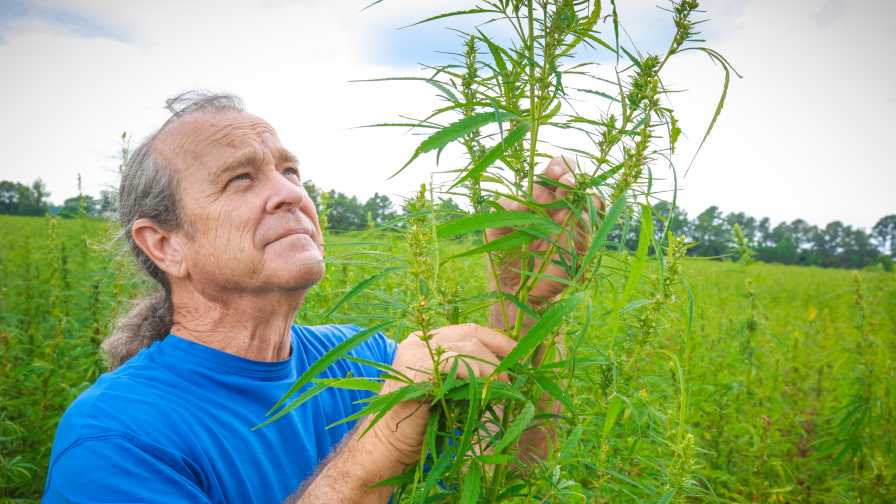Can Hemp Weave its Way into Fabric of Florida Farming?

Like many seeking to fill a niche with alternative crops, Bruce Perlowin, CEO of Hemp Inc. in Spring Hope, NC, is hopeful for federal legislation that fully supports the research, production, and distribution of industrial hemp. Meanwhile, Florida researchers are prepping to plant and track the progress of what could become a cash crop for the state.
Photo courtesy of CMW Media
Recently, the University of Florida Board of Trustees gave the green light to UF/IFAS researchers for the development of hemp management and cropping systems. The move was major in showing the university’s commitment to learning more about what could become a valuable alternative crop for the state’s agriculture producers.
Industrial hemp, a variety of the Cannabis sativa plant, has been cultivated for many millennia primarily as a fiber and grain crop. In addition, industrial hemp has multiple applications, such as for building materials, plastics, food, skin products, pain relief, and more.
Often confused with its cannabis cousin marijuana, industrial hemp contains considerably less of the psychoactive compound THC (less than 0.3% per dry weight) and requires minimal care in cultivation as opposed to the intensively controlled environment necessary for medicinal and recreational cannabis production.
A sign of the times, the action taken by UF leaders shortly preceded the filing of a bill by U.S. Senate Majority Leader Mitch McConnell (R-KY) that would remove hemp from the banned substances list and make the crop eligible for crop insurance.

Jerry Fankhauser
Jerry Fankhauser, Assistant Director of the Florida Agricultural Experiment Station and one of the research team members with UF/IFAS’ industrial hemp pilot project, says he’s not surprised to see this kind of legislation being pushed now. “More than 30 land grant institutions have — at some level — been doing field studies with industrial hemp since the 2014 Farm Bill allowed for such research efforts,” he says. “In addition, certain states like Kentucky have been more aggressive with permitting growers to plant industrial hemp.”
Bruce Perlowin, CEO of Hemp Inc., which boasts an 85,000-square-foot multipurpose industrial hemp processing facility in Spring Hope, NC, says passage of McConnell’s proposed Hemp Farming Act will have significant impact on U.S. production of hemp-based products like CBD oil. “Many farmers in America are struggling to make money on their current crops, and we see that hemp provides a viable income stream,” he points out. “Legalizing hemp at the federal level would allow for interstate commerce of America-grown hemp and hemp-derived products, providing a major boon for the industry.”
Perlowin goes on to echo Fankhauser’s thoughts regarding lawmakers’ change of perception on hemp, witnessing support from both sides of the political aisle. “Momentum has been building for decades,” he says. “As more states pass legislation to cultivate industrial hemp, we are seeing that more politicians recognize the value this plant provides for local economies. We strongly support this legislation and are hopeful for a positive outcome.”
First Steps
Despite playing a bit of catch-up, Florida could be in prime position to cash in on industrial hemp with its unique growing season and markets. Fankhauser says an agronomic team is ready to take on the project and looks forward to commencing with field studies to provide answers for the research goals. “There is solid interest from potential growers and those in the industry for industrial hemp field studies that could lead to the crop being grown in the state,” he exclaims.
Robert Gilbert, Professor and Chair of the UF/IFAS Agronomy Department and the lead oversight manager of the industrial hemp pilot project, says that to support the possible future sustainability of an industrial hemp industry in the Sunshine State, preliminary assessment of the crop and cropping systems must be established prior to commercialization consideration. The research program will be seeking to identify productive varieties that can withstand environmental, ecological, and even economic risks.
The research team also will study the risk of any hemp plants becoming invasive threats to Florida’s environment.
Plans are to establish industrial hemp plots in four different locations across the state. “We are in the process of choosing locations in South, Central, and North Florida to encompass the broad range of climate and soils where hemp may be grown,” Gilbert says.
Pros and Cons
The benefits are many for Florida growers potentially gaining access to an alternative crop that’s so high in demand. The ability to be a local provider of plant material for a burgeoning oil, fiber, and feedstock industry is appealing, but still daunting.
There is a learning curve, not only for researchers, but also for potential growers to consider. Given his prior experience with industrial hemp field studies at Purdue University, Fankhauser warns that crop establishment and weed control will be challenging under certain conditions. “Germination percentage of certain certified seed varieties seemed to be variable, which can lead to poor stands and significant weed pressure,” he says.
Taking the big picture into consideration, Fankhauser says the research team will be looking at plant growth and development on varying soils and climatic conditions. This includes varying environments ranging from southern temperate to tropical. “Day length and temperature differences may play a role in the performance of many of the certified varieties that are available at the present time,” he says.
Similarly, UF/IFAS and USDA researchers are currently examining the same environmental factors and their impact on Florida-grown hops. Coincidence? No. Hop plants are part of the Cannabaceae family, too.
Next Steps
In order for the UF/IFAS hemp pilot project to officially take off, the research program must get consent from federal and state legislative entities. “We still need to acquire approval from DEA to import certified industrial hemp seed as well as from Florida Department of Agriculture and Consumer Services to obtain planting permits for each experimental location,” Gilbert confirms.
As of this posting, permit approvals were still pending, but confidence was high among the team. “Once permits are secured, our research team will begin sourcing certified varieties for the four locations across the state where we plan to conduct agronomic field studies,” Fankhauser concludes. “Given the challenges associated with obtaining industrial hemp seed from other states, Canada, and even Europe, it may be late 2018 into 2019 before the first trials are in the ground.”
We’ll be watching, waiting, and hoping for success. Carry on!









